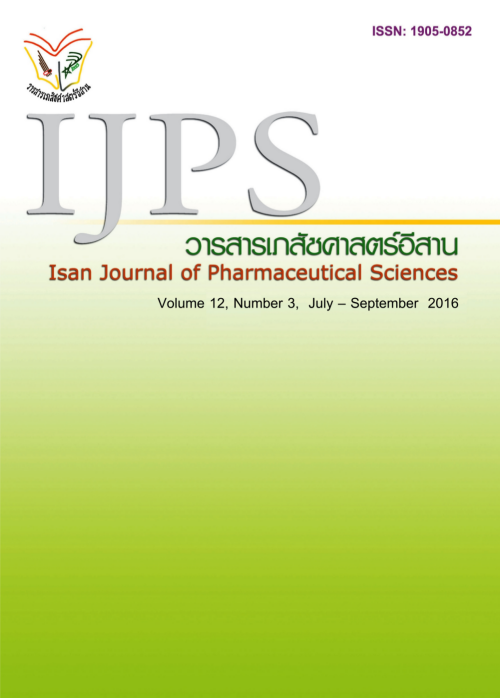Incidence Rate of Depression in Type 2 Diabetic Patients: 5-year Follow-Up Study
Main Article Content
Abstract
Introduction: Depression is one of the important comorbidities in patients with type 2 diabetes (T2DM). Therefore, screening and proper treatment can prevent its negative consequences. The objective of this retrospective cohort study was to identify the incidence rate of depression in T2DM patients. Materials and Method: Data were retrieved from electronic health records from one community hospital in Ubon Ratchathani province. Patients newly diagnosed with T2DM with ICD10 (E11) during January 1, 2007 and December 31, 2009 were included in this study and followed up for 5 years or when they were diagnosed with depression. Depression was identified by using ICD10 (F32-33) or receiving fluoxetine or sertraline at least for 3 months or presenting signs and symptoms of depression by depression screening tool from Department of Mental Health, Ministry of Public Health. Results: The results indicated that overall incidence rate of depression in T2DM patients was 14.83 per 1,000 person-years (95% CI = 12.25-17.96), 15.89 per person-years (95% CI = 12.53-20.16) among female and 13.21 per 1,000 person-years (95% CI = 9.57-18.23) among male. The incident rates of depression were 16.78 per 1,000 person-years (95% CI = 13.71-20.54), 6.38 per 1,000 person-years (95% CI = 3.19-12.76), and 13.46 per 1,000 person-years (95% CI = 4.34-41.75) in patients receiving oral antidiabetic agents only, insulin only, or combined therapy, respectively. Conclusion: Because the incidence rate of depression in T2DM patients is higher than in normal population, screening and early diagnosis of depression in T2DM patients should be implemented.
Article Details
In the case that some parts are used by others The author must Confirm that obtaining permission to use some of the original authors. And must attach evidence That the permission has been included
References
Ali S, Stone MA, Peters JL, Davies MJ, Khunti K. The prevalence of co-morbid depression in adults with Type 2 diabetes: a systematic review and meta-analysis. Diabet Med. 2006; 23 (11): 1165-73.
Anderson RJ, Freedland KE, Clouse RE, Lustman PJ. The prevalence of comorbid depression in adults with diabetes: a meta-analysis. Diabetes care. 2001; 24 (6): 1069-78.
Anonymous. Standards of medical care in diabetes--2015: summary of revisions. Diabetes care. 2015; 38 Suppl: S4.
Berge LI, Riise T, Tell GS, Iversen MM, Ostbye T, Lund A, et al. Depression in persons with diabetes by age and antidiabetic treatment: a cross-sectional analysis with data from the Hordaland Health Study. PloS one. 2015; 10 (5): e0127161.
Bureau of Epidemiology. Annual Epidemiology Surveillance Report. Ministry of Public Health (Thailand), 2013.
Icks A, Albers B, Haastert B, Pechlivanis S, Pundt N, Slomiany U, et al. Risk for high depressive symptoms in diagnosed and previously undetected diabetes: 5-year follow-up results of the Heinz Nixdorf Recall study. PloS one. 2013; 8 (2): e56300.
Kuptniratsaikul V, Pekuman P. The Study of the Center for Epidemiological Studies-Depression Scale (CES-D) in Thai People. Siriraj Hosp Gaz. 1997; 49: 442-48.
Lorant V, Croux C, Weich S, Deliege D, Mackenbach J, Ansseau M. Depression and socio-economic risk factors: 7-year longitudinal population study. Br J Psychiatry. 2007; 190: 293-8.
Lotrakul M, Sumrithe S, Saipanish R. Reliability and validity of the Thai version of the PHQ-9. BMC psychiatry. 2008; 8: 46.
Lunghi C, Moisan J, Gregoire JP, Guenette L. Incidence of Depression and Associated Factors in Patients With Type 2 Diabetes in Quebec, Canada: A Population-Based Cohort Study. Medicine. 2016; 95 (21): e3514.
Mathers CD, Loncar D. Projections of global mortality and burden of disease from 2002 to 2030. PLoS Med. 2006; 3 (11): e442.
Melchior M, Chastang JF, Head J, Goldberg M, Zins M, Nabi H, et al. Socioeconomic position predicts long-term depression trajectory: a 13-year follow-up of the GAZEL cohort study. Mol Psychiatry. 2013; 18 (1): 112-21.
Mezuk B, Eaton WW, Albrecht S, Golden SH. Depression and type 2 diabetes over the lifespan: a meta-analysis. Diabetes care. 2008; 31 (12): 2383-90.
Muangthai S. Prevalence and Factors Associated with Depression in Sisaket’s Primary Care Patients with Type 2 Diabetes. Medical journal of Srisaket Surin Buriram hospitals. 2013; 28 (2): 109-20.
Rotella F, Mannucci E. Diabetes mellitus as a risk factor for depression. A meta-analysis of longitudinal studies. Diabetes Res Clin Pract. 2013; 99 (2): 98-104.
Suppaso P. The Prevalence of Depression among Type 2 Diabetic Patients in PhangKhon Hospital. Srinagarind Medical Journal. 2010; 25 (4): 272-79.
World Health Organization. 10 facts about diabetes 2016 [cited 2016 April 28]. Available from: http://www.who.int/features/factfiles/diabetes/en/.


